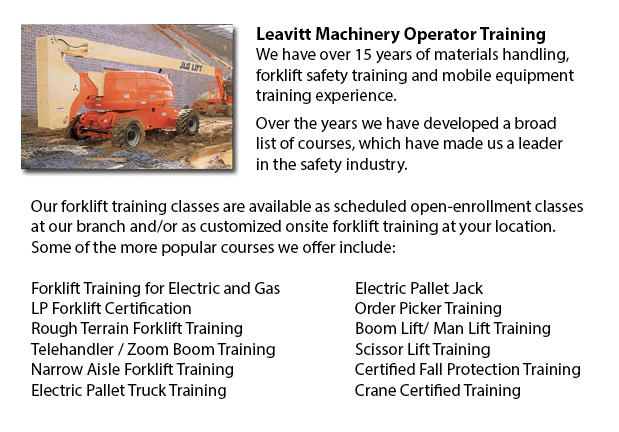
Sudbury Aerial Lift Safety Training - Every year, there are roughly 26 construction fatalities attributed to the use of aerial lifts. Nearly all of the craftsmen killed are laborers, electrical workers, carpenters, painters or ironworkers. The majority of the fatalities are caused by electrocutions, falls and tip-overs. The greatest danger is from boom-supported lifts, like for instance cherry pickers and bucket trucks. The majority of the fatalities are connected to this particular kind of lift, with the rest involving scissor lifts. Other hazards comprise being thrown out of a bucket, being struck by falling things, and being caught between the lift bucket or guardrail and an object, such as a steel beam or joist.
The safe operation of an aerial lift needs a check on the following things prior to using the device: emergency and operating controls, personal fall protection gear, safety devices, and tires and wheels. Check for possible leaks in the air, fuel-system, hydraulic fluid. Check the device for loose or missing parts.
The place where the device will be utilized must be carefully inspected for potential hazards, like bumps, holes, drop-offs and debris. Overhead power lines must be avoided or closely monitored. It is recommended that aerial lift devices be utilized on stable, level surfaces. Never work on steep slopes that go beyond slope limits which the manufacturer specified. Even on a level slope, brakes, wheel chocks and outriggers should be set.
Businesses must provide their aerial lift operators with the correct guidebooks. Operators and mechanics must be trained by a licensed person experienced with the applicable kind of aerial lift.
Aerial Lift Safety Tips:
o Close doors or lift platform chains before operating.
o Leaning over and climbing on guardrails is prohibited. Stand on the platform or floor of the bucket.
o Make use of the provided manufacturer's load-capacity limitations.
o When working near traffic, make use of appropriate work-zone warnings, such as cones and signs.
If right procedures are followed, electrocutions are preventable. Stay at least 10 feet away from any power lines and certified electricians must insulate and/or de-energize power lines. Workers need to make use of personal protective tools and equipment, like a bucket that is insulated. Nevertheless, an insulated bucket does not protect from electrocution if, for example, the person working touches another wire providing a path to the ground.
Falls are avoidable if the worker remains secure in guardrails or in the bucket by utilizing a positioning device or a full-body harness. If there is an anchorage inside the bucket, a positioning belt with a short lanyard is acceptable.
By following the manufacturer's instructions, tip-overs could be avoided. Never drive the lift platform when it is elevated, unless otherwise specified by the manufacturer. Adhere to the device's horizontal and vertical reach limits, and never exceed the load-capacity which is specified.
-
Wheel and Track Loader Training in Sudbury
Lift trucks are obtainable in several different models that have different load capacities. The majority of average forklifts used in warehouse environment have load capacities of 1-5 tons. Bigger scale units are utilized for heavier loads, like for... More -
Sudbury Aerial Lift Certification
Sudbury Aerial Lift Certification - Aerial Lift Certification is for individuals who requires an in-depth understanding of aerial lift safety. Inspectors and operators, supervisors, maintenance workers and construction craftsmen must perform a traini... More -
Sudbury Forklift Certification Schools
Sudbury Forklift Certification Schools - Within North America, forklift certification is mandatory, making forklift training programs necessary for both the company and their employees working as forklift operators. Forklift training focuses on healt... More -
Sudbury Boom Lift Operator Training
Sudbury Boom Lift Operator Training - A cherry picker refers to a type of aerial work platform. Cherry pickers include a platform or bucket at the end of a hydraulic lifting system. The device is likewise called a man lift, boom lift, basket crane or... More -
Sudbury Telehandler Certification
Sudbury Telehandler Certification - Telehandler certification programs are both for operators who have some experience driving a standard forklift and for those with no experience. The real-world training offered by these courses produces graduates w... More -
Operator Safety Training, Re-Qualification Training, In-House Instructor Training in Sudbury
Lift trucks are utilized in just about all industrial construction sites and in warehouse operations and in boat yards. The reach feature of a lift truck is a vital component used in several applications like for example when a shelving system is bei... More -
Crane / Overhead Crane / Self-Erect Crane / Truck Mounted Crane / Hydraulic Cranes Training in Sudbury
Bridge cranes or overhead cranes are a type of industrial material handling crane making use of a line and hook apparatus which runs on a horizontal beam running along two widely separated rails. Lots of overhead cranes could be seen in a long factor... More -
Sudbury Forklift Safety Training
Sudbury Forklift Safety Training - Anyone who wants to operate a lift truck should take a forklift safety training course in order to become a certified forklift truck operator. There are a variety of ways to obtain forklift training. Programs are pr... More

Forklift Certification Sudbury
TOLL FREE: 1-888-254-6157
Sudbury, Ontario
forkliftcertificationsudbury.com
Email Us
About Us


